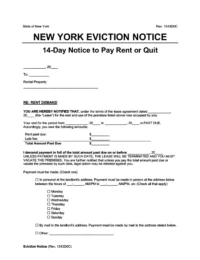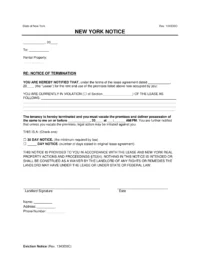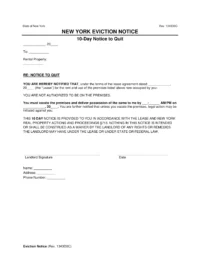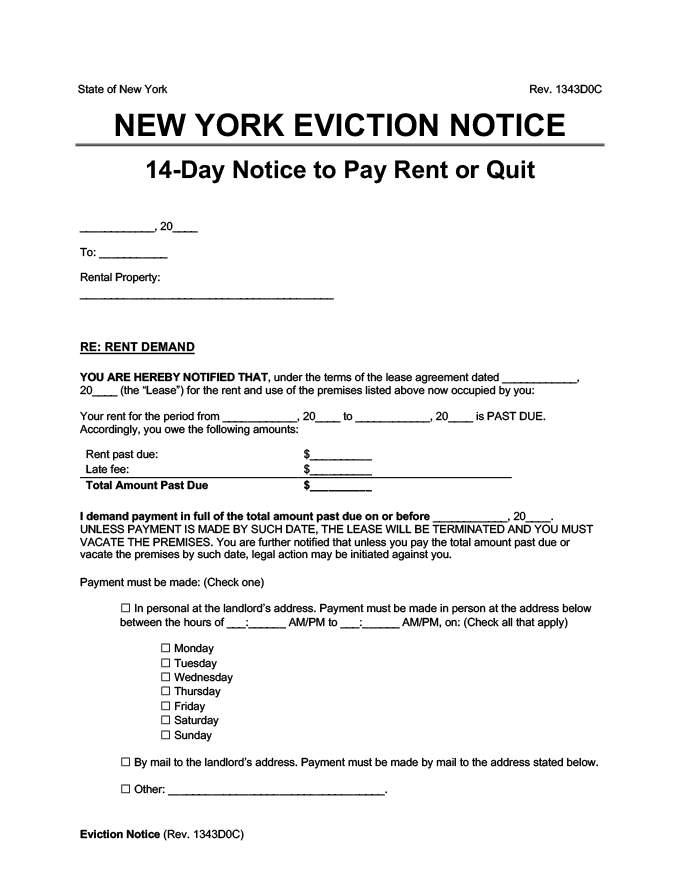Understanding Eviction Notices in New York
Eviction in New York starts with a written notice. The correct type of notice is based on the situation, like unpaid rent or lease non-compliance, and must be served before a landlord can go to court.
Use our document editor to create a custom New York eviction notice and download it in your preferred format, either PDF or Word.
Types of Eviction Notices in New York
New York provides structured notice periods for residential evictions, which vary based on the reason for eviction.
14-Day Notice to Pay Rent or Quit
Use this form to inform tenants who have not paid rent that § 711(2) grants them 14 days to pay or leave the property. Landlords must wait until five days past the rent due date to send a pay rent or quit notice.
14-Day Notice to Pay Rent or Quit
Evict a tenant if they haven’t paid rent on time.
30-Day Notice to Quit for Non-Compliance (Curable)
This form informs a tenant that they have committed a breach of the lease. Once the landlord presents this notice to the court, the court can issue a 30-day warrant. During this period (under § 753(4)), the tenant must either correct the violation or prepare to vacate the property, as failure to comply will result in eviction.
30-Day Notice to Quit for Non-Compliance (Curable)
Begin evicting a tenant if they’ve broken the terms of your lease and the violation is curable (i.e., “fixable”).
30-Day Notice to Quit for Non-Compliance (Incurable)
Issue this form to officially declare the commencement of eviction proceedings due to an incurable lease violation. This document signals the termination of the tenancy, giving the tenant a 30-day period to vacate the property. This notice, when filed in court, may lead to the court issuing a formal 30-day eviction order. During this timeframe, the tenant is required to prepare to vacate the premises.
30-Day Notice to Quit for Non-Compliance (Incurable)
Begin evicting a tenant if they’ve broken the terms of your lease and the violation is incurable.
10-Day Notice to Quit for Squatting
Alert an unauthorized occupant, such as a squatter or licensee (a tenant’s guest who stays without the landlord’s consent), from the property.
This notice warns that remaining in the property after the specified date can lead to court proceedings in a holdover case. The eviction process, including legal action, can only commence after at least ten days from the notice’s issuance per § 713.
10-Day Notice to Quit for Squatting
Evict someone who's squatting on your property.
30-Day Notice Lease Termination
This form helps landlords end month-to-month leases. It provides tenants with a 30-day notice period under § 232-A and § 232-B. To avoid legal consequences, tenants must vacate the property by the conclusion of this period. No specific reason is needed to terminate a monthly lease, provided the correct notice duration is observed.
30-Day Notice Lease Termination
Let a tenant know that you’re ending a lease and that they must prepare to leave your property.
How to Evict a Tenant in New York
In New York, evictions are governed by Article 7, Real Property Actions & Proceedings of the Consolidated Laws of New York.
Step 1: Provide Notice
Before the landlord can begin the eviction process in New York, the landlord must provide notice of the non-payment of rent or lease violation. If the eviction is due to a non-rent related lease violation, the landlord provides a notice to quit or cure, and the tenant has ten days to correct the violation. If the tenant corrects it, no further action can be taken. If the tenant doesn’t correct it, the landlord can provide a lease termination notice.
If the landlord is evicting the tenant for not paying rent, the landlord must first provide a late rent notice. The tenant has 14 days from the date of the notice to pay the rent.
Step 2: Prepare the Necessary Legal Documents
The landlord prepares the necessary Notice of Petition and Petition, citing why the landlord is evicting the tenant.
A Notice of Petition provides written notice to a tenant that a court case has been filed. This notice tells the tenant when and where to come to court.
A Petition starts the legal case and establishes the facts that give the landlord the right to evict their tenant(s).
Step 3: File the Petition and Notice of Petition
The landlord files a Petition with the district or housing court of the county where the rental unit is located. The court clerk gives the landlord a court date, time, and place, which is included in the Notice of Petition. The court date must be between 10 and 17 after the tenant is served with these documents.
Step 4: Serves the Tenant With the Notice of Petition and Eviction Petition
The landlord must legally serve the tenant with the documents. This usually includes leaving the notice at the tenant’s door or having a private or public process server serve the tenant with the papers.
Step 5: Wait for Tenant to Provide an Answer
The tenant can contest the statements in the petition and state their defense. For instance, a valid defense could be that the tenant paid rent after the eviction process began and was accepted, or the landlord asked for additional damages not permitted by New York law.
Step 6: Attend the Court Hearing
The burden of proof is on the landlord, meaning it’s their responsibility to prove their case at the hearing. However, the landlord can ask for a default judgment if the tenant does not appear at the New York court hearing or provide an answer.
Step 7: Await a Judgment and Warrant for Eviction
Once the judge signs the judgment, the landlord can obtain a warrant for eviction. The sheriff posts this notice on the rental unit, and the tenant has 72 hours to vacate the property.
Step 8: Proceed With the Eviction
A marshal or sheriff may physically remove the tenant from the premises. The landlord can also change the locks to the rental unit at that time.
Related Court Forms
New York offers an interactive program that provides the court forms you need for a lawful eviction. You can register for a free account and then provide basic information about the landlord, tenant, the unit, and the reason for eviction. Written instructions can also be printed so the landlord can follow them step-by-step.
The necessary forms automatically populate, including the rent demand, also known as a late rent notice. This form warns the tenant that they’ll be evicted if they don’t pay the past-due rent. It also informs the tenant of the months and amounts of rent they owe and must be given to the tenant at least 14 days before the case is started.






